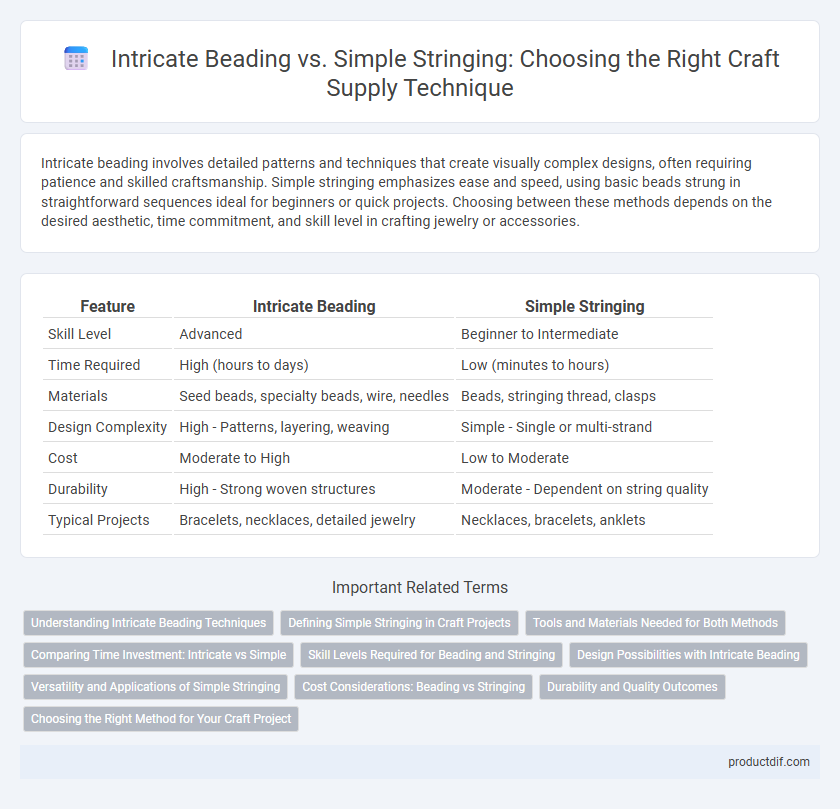Intricate beading involves detailed patterns and techniques that create visually complex designs, often requiring patience and skilled craftsmanship. Simple stringing emphasizes ease and speed, using basic beads strung in straightforward sequences ideal for beginners or quick projects. Choosing between these methods depends on the desired aesthetic, time commitment, and skill level in crafting jewelry or accessories.
Table of Comparison
| Feature | Intricate Beading | Simple Stringing |
|---|---|---|
| Skill Level | Advanced | Beginner to Intermediate |
| Time Required | High (hours to days) | Low (minutes to hours) |
| Materials | Seed beads, specialty beads, wire, needles | Beads, stringing thread, clasps |
| Design Complexity | High - Patterns, layering, weaving | Simple - Single or multi-strand |
| Cost | Moderate to High | Low to Moderate |
| Durability | High - Strong woven structures | Moderate - Dependent on string quality |
| Typical Projects | Bracelets, necklaces, detailed jewelry | Necklaces, bracelets, anklets |
Understanding Intricate Beading Techniques
Intricate beading techniques involve precise patterns, multiple bead types, and detailed designs that create complex textures and visual depth, enhancing the overall craft supply project. Mastery of these techniques requires knowledge of specialized tools such as fine beading needles, various thread types, and bead positioning strategies to achieve durability and aesthetic appeal. Understanding the nuances of bead weaving, peyote stitch, and right-angle weave expands creative possibilities beyond the straightforward nature of simple stringing methods.
Defining Simple Stringing in Craft Projects
Simple stringing in craft projects involves threading beads or charms onto a single strand, typically using wire, nylon, or elastic cord. This technique emphasizes ease and speed, making it ideal for beginners or quick jewelry creations. The focus remains on showcasing individual beads while maintaining a clean and minimalistic design.
Tools and Materials Needed for Both Methods
Intricate beading requires specialized tools such as fine needles, bead mats, and precision pliers, along with materials like seed beads, crystals, and strong beading thread to achieve detailed designs. Simple stringing uses basic tools like scissors and crimping pliers, paired with materials such as elastic cord, leather strings, and larger beads for quick and straightforward jewelry creation. Selecting quality tools and materials tailored to each method greatly impacts the durability and aesthetic of the finished craft.
Comparing Time Investment: Intricate vs Simple
Intricate beading requires significantly more time investment due to the detailed patterns and precision needed for each bead placement, often extending crafting sessions by hours compared to simple stringing. Simple stringing involves rapidly threading beads onto a cord with minimal pattern constraints, allowing for faster project completion and ideal for beginners or quick crafts. Choosing between intricate beading and simple stringing depends largely on the desired design complexity and available crafting time.
Skill Levels Required for Beading and Stringing
Intricate beading demands advanced skills including precision, patience, and familiarity with complex patterns and tiny beads, making it ideal for experienced crafters. Simple stringing requires basic skills such as threading beads onto a string or wire, suitable for beginners and quick projects. Skill levels differ greatly, with intricate beading involving detailed techniques like bead weaving, while stringing focuses on assembling beads efficiently with minimal technical challenges.
Design Possibilities with Intricate Beading
Intricate beading offers extensive design possibilities through complex patterns, multi-layered textures, and the combination of various bead shapes and sizes, enabling unique and personalized jewelry creations. This technique allows crafters to incorporate detailed motifs and vibrant color gradients that simple stringing cannot achieve, enhancing visual interest and craftsmanship. Using intricate beading, artisans can transform ordinary materials into sophisticated pieces with dimensional depth and intricate artistry.
Versatility and Applications of Simple Stringing
Simple stringing offers exceptional versatility in craft supply projects, making it ideal for beginners and advanced crafters alike. It enables the creation of a wide range of jewelry pieces, including bracelets, necklaces, and anklets, using various materials like beads, cords, and wires. This technique supports diverse applications, from casual everyday accessories to elegant statement pieces, enhancing its appeal in both casual and professional crafting environments.
Cost Considerations: Beading vs Stringing
Intricate beading often requires specialized tools and a wider variety of beads, increasing material costs compared to simple stringing, which uses basic cords and fewer components. Beading also demands more time and skill, potentially raising labor expenses for handcrafted pieces. Simple stringing offers a budget-friendly option ideal for beginners or bulk projects without sacrificing style.
Durability and Quality Outcomes
Intricate beading offers enhanced durability due to the use of multiple secure knots and reinforced thread patterns, ensuring long-lasting jewelry pieces. Simple stringing prioritizes ease and speed but often compromises on strength, making it more prone to breakage over time. High-quality outcomes in craft projects depend on choosing intricate beading for resilience and refined aesthetic appeal.
Choosing the Right Method for Your Craft Project
Intricate beading offers detailed designs using small beads and complex patterns, ideal for creating unique, eye-catching jewelry pieces or embellishments. Simple stringing provides a quicker, more straightforward approach with fewer materials, perfect for beginners or projects requiring flexibility and ease. Choosing between these methods depends on the desired complexity, time commitment, and skill level of the craft project.
Intricate Beading vs Simple Stringing Infographic

 productdif.com
productdif.com